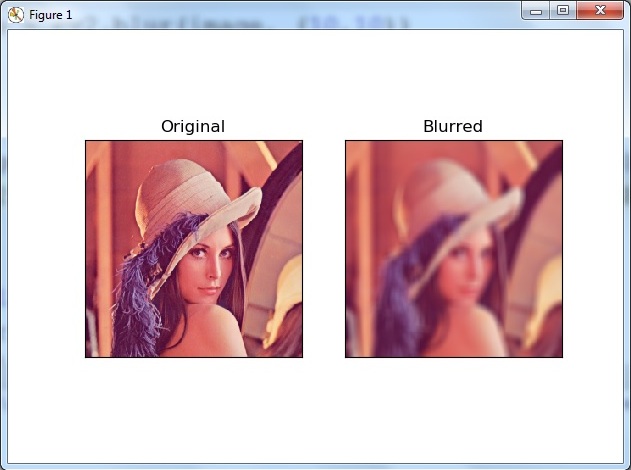In this OpenCV article we are going to talk about Averaging Image Blurring in Python OpenCV.
so according to OpenCV Documentation Averaging is done by convolving an image with a
normalized box filter. It simply takes the average of all the pixels under the kernel area and
replaces the central element. you can do this by using cv2.blur() function.
Read More Image Smoothing Techniques in OpenCV
1: OpenCV Gaussian Blurring for Images in Python
2: OpenCV Median Blurring for Images in Python
3: OpenCV Smooth Image with Bilateral Filtering
So this is the complete code for OpenCV Averaging Image Blurring in Python
|
1 2 3 4 5 6 7 8 9 10 11 12 13 14 15 16 17 18 19 20 21 22 23 24 25 26 |
import cv2 import matplotlib.pyplot as plt image = cv2.imread('lena.tif') #ksize = kernel size You can change the kernel size as you want blurred_image = cv2.blur(image, (10,10)) #convert the image from bgr to rgb original_image = cv2.cvtColor(image, cv2.COLOR_BGR2RGB) blurred = cv2.cvtColor(blurred_image, cv2.COLOR_BGR2RGB) plt.subplot(121) plt.imshow(original_image),plt.title('Original') plt.xticks([]), plt.yticks([]) plt.subplot(122),plt.imshow(blurred),plt.title('Blurred') plt.xticks([]), plt.yticks([]) plt.show() cv2.waitKey(0) cv2.destroyAllWindows() |
This line of code is used for reading of the image, make sure that you have added an image
in your working directory.
|
1 |
image = cv2.imread('lena.tif') |
So after that we are going to use cv2.blur() function for making smooth our image. we need
to give some parameters for this function, so the first one is our source or image that we want
to do blurring and the second is the ksize or kernel size, you can change this according to your
choice.
|
1 |
blurred_image = cv2.blur(image, (10,10)) |
Because we are going to show our images in Matplotlib, so Matplotlib uses RGB (Red, Green, Blue)
color system, and OpenCV uses BGR (Blue, Green, Red) color system, we need to convert the BGR
color to RGB. if we don’t do this there will be messed up in the color.
|
1 2 |
original_image = cv2.cvtColor(image, cv2.COLOR_BGR2RGB) blurred = cv2.cvtColor(blurred_image, cv2.COLOR_BGR2RGB) |
Note: cv2.waitKey() is a keyboard binding function. Its argument is the time in milliseconds.
the function waits specified milliseconds for any keyboard event. If you press any key in that
time, the program continues. If 0 is passed, it waits indefinitely for a key stroke.
So run the complete code and this will be the result.

Subscribe and Get Free Video Courses & Articles in your Email
Comments are closed.